The answer to your impossible question is, 'Good.' A lot of people have asked me how it was, how the visit went, if I liked it, etc., already. The answer is, truthfully, that it was good. I mean, it was good in that way that it was something I have always wanted to see after having read about the concentration camps for so long, and it was certainly interesting, and it was educational. But yes, it was also sad, and peaceful, and haunting. It was needed, too… to see it, to feel it, to understand. Perhaps the best way to describe it was to say that it was heavy. It left a mark, for sure.
I suppose this will be quite picture-heavy, just with notes about what you're seeing because I don't really know what else I can do; there are still more photos here. There's not a way to explain everything, of course. There's just no way to describe it, honestly.
Though Dachau was never intended to be a Death Camp, it was the first Concentration Camp and saw much death -- it was meant to be a place where people were sent to be worked to the limits, fed the bare minimum, and kept on the brink of survival so as to be benefit to the Third Reich; by keep a concentration camp over a death camp, the Nazis gained slave labour and it is what kept Germany going throughout the war years.
It served as a prototype for all future concentration camps, no matter their purpose -- whether it was confinement or a death factory. This means it is most representative of the camps as a whole, all which differ greatly in function and execution, for it contains every idea the Nazis put into motion.

Just outside the entrance, SS office in the foreground and a watchtower in the background.

"Work Brings Freedom."
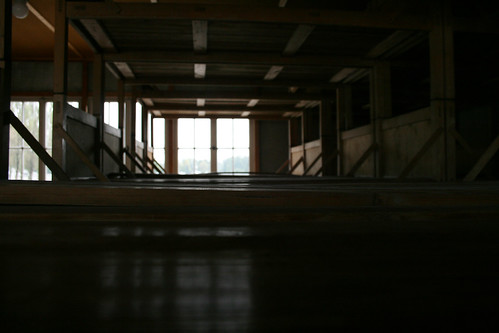
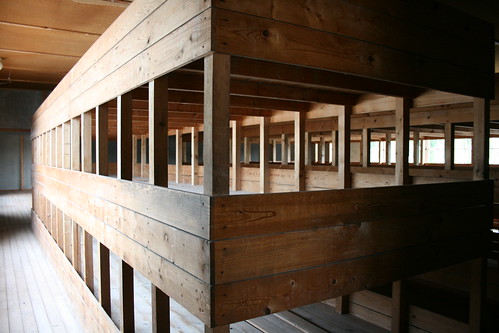
Barracks. The 'sea of beds.' The first was the middle stage of Dachau's functional years, the second is the last year or so when the camp was overfilled with prisoners. What was meant to house no more than 200 men in the beginning was being used to house near 2,000.

The original barracks were torn down in the 60s and a recreation was made in the place of one. The rest have had cement-and-rock foundations put over where the real buildings once stood. Out of every window you can see a watchtower; perhaps it's every watchtower can see into every window.

The open area just in front of the barracks where role call was done every morning and evening. Dachau, the first concentration camp and the prototype, was made to hold 6,000 maximum prisoners. When Allied troops freed it, it held near 32,000 prisoners -- nearly the same amount of recorded deaths for Dachau. They were all held here at only those times, and the lot was held accountable for every single person -- if one were missing, they would all suffer, and many times this forced them to drag corpses of fallen friends and family along with them as they stood at attention to be counted for hours.
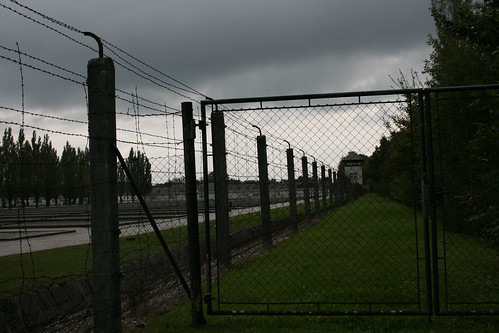
Security, from the outside, on the way back from the crematorium. The furthest bit of grass was the 'Death Strip,' where prisoners would be shot just for stepping there, next the cement canal, and finally the electric barbed wire fence, all surveyed by a watchtower equipped with multiple guards and machine guns. Many prisoners who could no longer take the abuse, 'went to the wire,' where they threw themselves onto it to end their life.
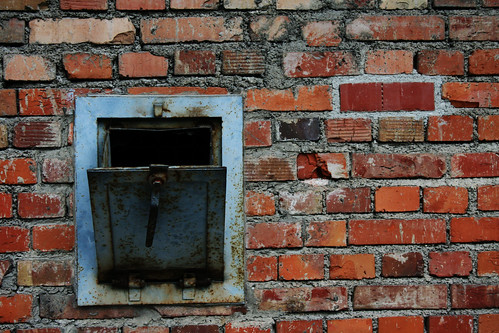
Zyklon B insertion capsule in the 'showerhouse.' This is where the canisters were inserted from the outside of the building. Hot air would then run on them and heat them. At a certain heating point, the Zyklon B pellets would turn to gaseous cyanide and poison any prisoner locked into the air-tight room in minutes. It was a means of mass extermination. This was where the idea was perfected so that it could be used on a larger scale at some of the most famous Death Camps, such as Auschwitz-Birkenau.
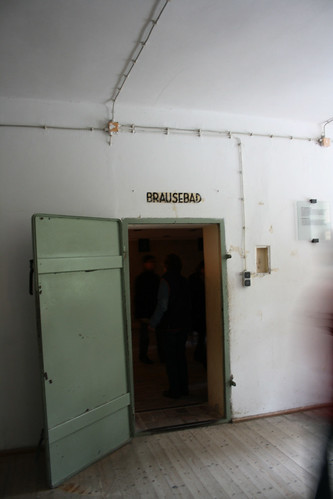
'Brausebad' -- 'Showerhouse.' The room where the poison gas was designed to kill people. The whole building hasn't a water line leading to it in this room, all the showerheads capped an empty hole.
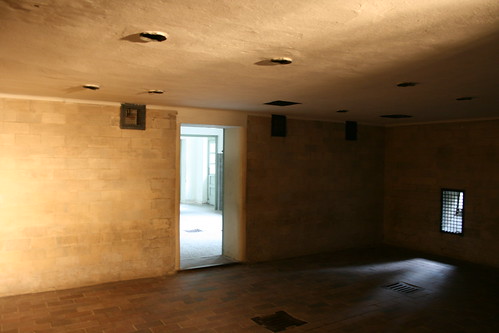
Don't let the false lighting filling the room fool you. The little window was the only light in the Brausebad. The top shows where the showerheads fit over.
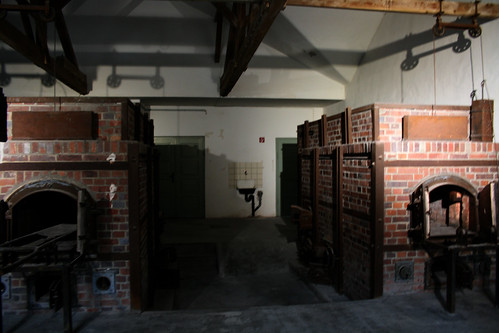
The old crematorium only held two small ovens so they built the new crematorium shortly after the beginning of the war. It now held 4 large coal-burning ovens so that they easily quadrupled their ability to cremate the remains of the prisoners. The back had a sink for the workers for they were told they must always keep clean and they would be punished more severely if they were dirty from working with the coal and ashes of their fellow men.
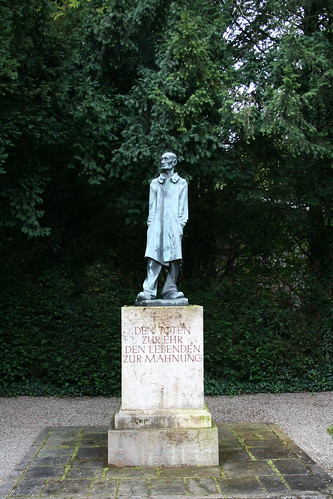
The Unknown Prisoner. He is in a defiant, casual pose because he has refused to be degraded and made to feel inhuman. He is a representative of all whom lost their lives in the camp. "Den Toten zur Ehr. Den Lebenden zur Mahnung." To Honor the Dead. To Warn the Living.
There is one place I did not -- could not -- take a picture. It is a small wooded area behind the crematorium, a gravel path the runs off the side of the rest of it. If you take the path, you soon find a neatly trimmed mound of greenery bursting up out of a dark, blackened soil. Here there is a headstone or sorts, one that simple bears the words in a few languages, "Ashes of thousands of unknown prisoners are buried here." It felt disrespectful to snap a picture of this. The whole wood here then turned to a small path that wound its way through the forest a bit, under a canopy of lush, vine-covered trees, until it bled back out onto the main path past the crematorium. It was peaceful here, not a sound, you couldn't hear the person beside you breath and the gravel beneath your feet was muted. It was cold, horribly cold even, but it was peaceful, and easy to breath. It is here where the waves of sorrow could wash over you, but you were also comforted by the serene feeling the woods and green and quiet brought you. This is what I mean when I say the visit was heavy.
It was an amazing experience, I'm glad I went, even if it's left me quieter and more pensive than normal the last day and a half. Dachau… it was good.
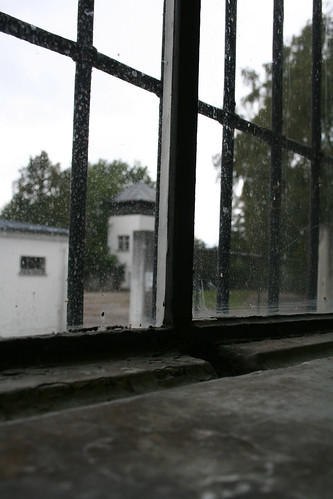
2 comments:
I see what you mean by "heavy"... but I really like those photos of the windows looking out at the watchtowers.
I totally understand.. It's not easy to put into words what it makes you feel. When I went on my Berlin/ Prague trip we went to Theresienstadt, which is where all the musicians went, and most people went through at one point. I'm now playing a woodwind quintet piece that was written there... and the opera this semester is Brundabar, also written at Theresienstadt. I was so happy I went, though... It's a part of history that I don't think should be forgotten...
Post a Comment